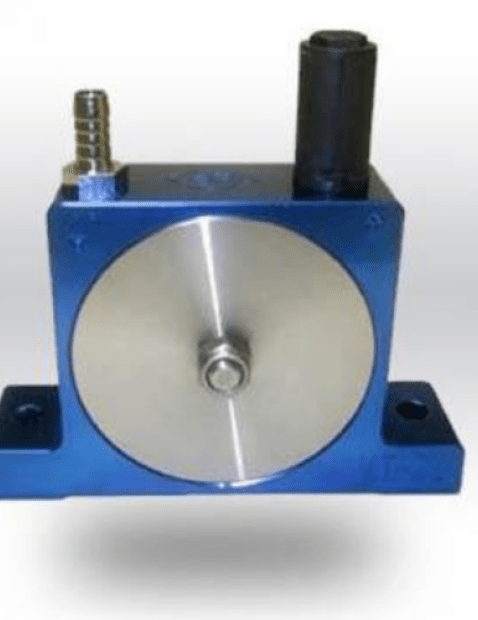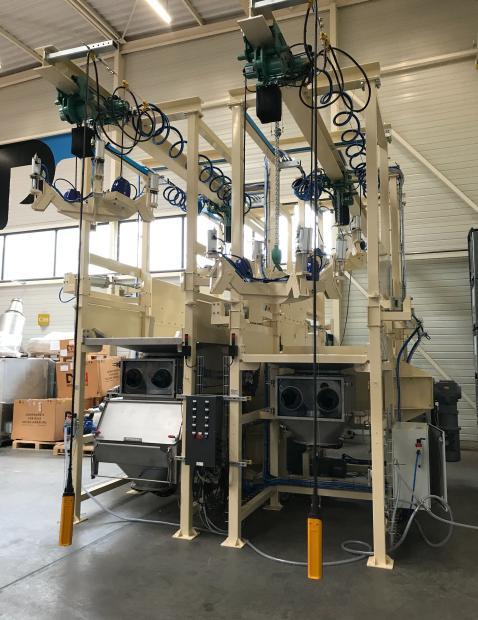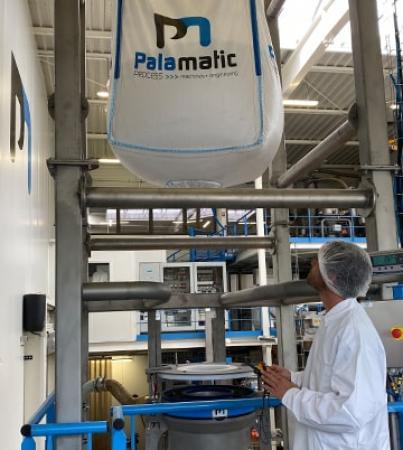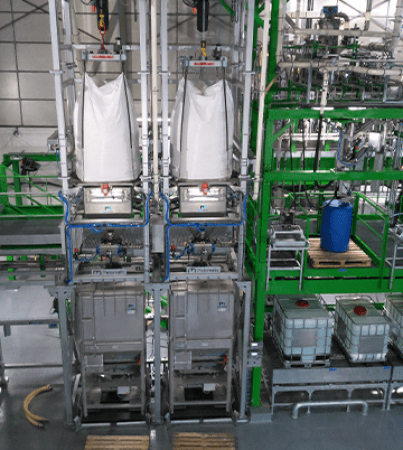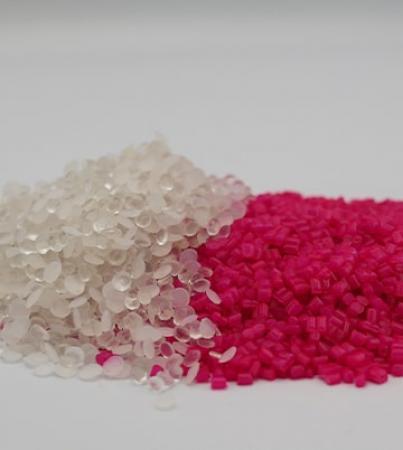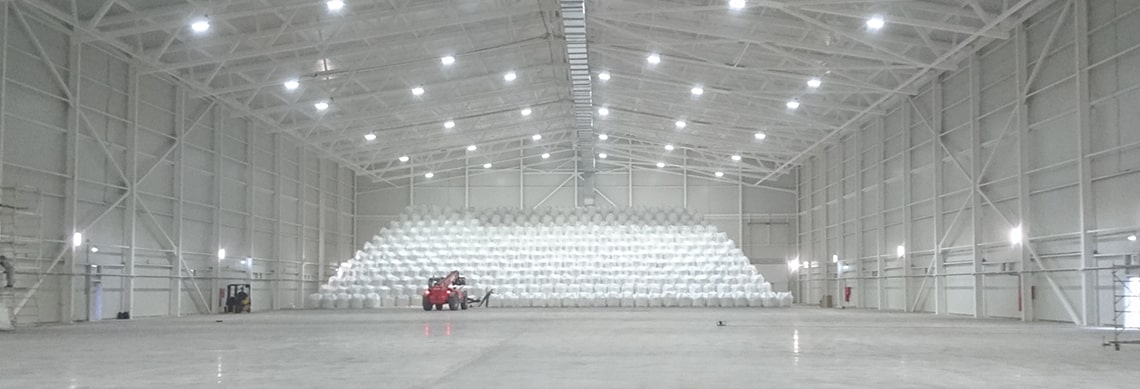
Not all big bags are created equal. There are actually quite a few features to consider when selecting the right type of super sack for safely storing and transporting your dry bulk materials. Typically made from woven polypropylene, they can be tailored to the user’s specific request and usually hold about 2,000 – 4,000 lbs of dry, free-flowing material.
Also known as FIBC’s (flexible intermediate bulk containers), they can be a cost-efficient bulk material handling solution and are easily moved around on pallets, or by the attached lift loops. Most big bags come in fairly standard sizes; however, big bag suppliers can offer tailor-made dimensions based on the client’s application. Let’s explore some of the more important design and safety features all material handling manufacturers should take into consideration when selecting the right big bag.
1. Are the powders you store considered explosive or flammable?
As big bags are filled and emptied, the flow of fine powders and granular particles can cause a build-up of static electricity. Being able to safely discharge the static is imperative to safely handling powders that could potentially ignite. Therefore, big bags are typically offered in 4 categories for how to handle static build-up: Type A, B, C, and D.
Type A Big Bags are the most standard and basic of the four categories. Made of polypropylene and other non-conductive fabrics, static electricity is generated as product rubs against the inside of the big bag. There is no static prevention offered in the Type A category. These bags can be used to transport and store non-flammable materials and when no flammable gases or vapors are present. These big bags should not be used in an atmosphere that has an MIE of ≤1,000mJ.
Type B Big Bags are made of similar material that Type A bags are made from. However, the difference between these types is how B manages to prevent sparks. The standard poly material develops a charge when material or someone brushes up against it.
But Type B bags use a thin coating which allows space between the fabric. This allows the bag to breakdown voltage build up in the fabric <6kV to prevent a spark that could cause an explosion.
owever, it’s important to note that this category of big bags is not considered ant-static. Therefore, they can be used in the transport and storage of flammable products, but not when flammable gases and vapors may be present. They are intended for use in environments with dust ignition energies <3mJ.
Type C Big Bags, also known as conductive or ground-able FIBCs, are made from the same polypropylene threads except they are interwoven with conducting threads.
The threads are electrically interconnected and the bag can be connected to a designated ground/earth during filling and unloading. It is essential the Type C big bag is grounded during use or the functionality of the conductive threads will be lost. Therefore, these bags can be used on combustible materials even when flammable gases and vapors are present. They should not be used if the grounding connection is broken or damaged.
Type D Big Bags are made from anti-static and static dissipative fabrics that can prevent a spark. The added benefit of Type D big bags is that they do not need to be grounded, instead they can safely dissipate any static into the surrounding atmosphere.
The woven fabrics contain quasi-conductive yarns and can be safely used to store combustible or flammable materials.
Do not use this big bag if the surface is coated with a conductive material such as grease or other flammable materials.

If your require further assistance,
I am at your entire disposal.
Loïc, expert in powders
2. What types of liners and coatings are there and why are they used?
Polypropylene liners are plastic liners inserted into FIBCs to provide an additional layer of protection. The most common use for these liners is either when the material is so fine it could potentially leak through the woven material, or an additional barrier is needed to protect against moisture.
Commonly used in the food industries and pharmaceutical industries, they can be combined with a multi-use bulk bags to allow the operator to get more life out of their bags.
The liners can easily be removed from the FIBC, discarded and replaced with a new liner allowing the big bag to be re-used.
Lined big bags can offer the advantage of already having the FIBC supplied with the liner sewn in. They also offer a few options to consider for different types of liners. First, there are lay-flat liners which are the most common type. They are often cylindrical in shape and have an open top with a heat-sealed bottom. They offer the following advantages: oxygen barrier, moisture barrier, chemical resistance, anti-static properties, and high tensile strength.
Form-fit liners are specifically designed to take the exact form of the bag, including the inlet and outlet spout. They offer the advantage of avoiding pleats and wrinkles, trap points for material to get stuck in. They ultimately offer similar benefits as lay-flat liners with the addition of less wrinkles and folds inside the bag to aid in complete material discharge.
Baffle liners are form fitted to the outer container and make use of internal baffles to maintain a square shape. This can help prevent the big bag from becoming rounded off as it fills with material. Because of this, they are often a space saver when loading onto trucks or storing in a warehouse. This helps increase the stack-ability and stability of the big bag and can hold, in some cases, up to 30% more product in a given space.
They also offer the advantage of protecting the product from contamination and provide a formed inlet and outlet spout. Aluminum liners provide excellent moisture, oxygen and UV protection and are compatible with a variety of bags. They excel at preventing product contamination and damage and can protect the quality and integrity of the material inside.
Coated Big Bags have a similar construction to standard bags, but before the bag is sewn an additional polypropylene film is added to the bag’s fabric. This helps seal any small gaps between the standard woven fabric. The coating offers some versatility in the sense that it can be applied to either the inside or the outside of the bag.
However, applying the coating on the inside is most common since fine powders could get trapped in the weaving if the coating was applied to the outside.
The main advantage is simply providing your materials that extra layer of protection while in storage. The most common uses are when you are transporting dry flow-able products in powder, crystal, granule or flake form (i.e., cement, detergents, flour, salt, sugar, fine minerals such as carbon black and sand).
It’s not uncommon for coatings and liners to be used together to add an extra layer of protection for sensitive material handling solutions. Coating barriers can be a very economical option to liners, but they don’t offer as much protection against outside contamination.
If you are storing very fine powders, it is recommended that you look at physical liners rather than coated bulk bags. Because of the nature of flexible woven fabrics, fine particulates can end up seeping through even when used with a coated big bag.
The decision to use a removable poly-liner or a pre-installed liner comes down to two factors: do you want to get multiple uses out of the same bag and/or do you need a specialty liner (aluminum, baffle, etc.). Removable liners usually only come in one material, which means you cannot get any special removable liners made of aluminum, for example.
So, if you do need a specialty liner, you will need to get a big bag with one pre-installed. But if that is not necessary, then removable liners are easy to insert and discard for re-use of the big bag.
3. What are the safety classifications of big bags and how do they apply?
You may have heard of bulk bag safety ratios such as 5:1 and 6:1. It is important to know how to safely use bulk bags for bulk material storage and transport. Understanding the max working load and what bags are safe for re-use and which ones are not, are largely determined by the bag’s safety rating.
5:1 FIBCs are designed for one use / one trip powder handling situations. The ratio 5:1 means they are designed to hold five times the amount of their safe work load (SWL). It is important to make note that even though this rating is designed to hold 5x the safe working load, one should never attempt to surpass the manufacturer’s recommended max fill load.
6:1 FIBCs are designed for multiple uses / multiple trips. As you may have already guessed, these bags are designed to hold 6 times their rated safe working load. However, the same word of caution here is never to exceed the manufacturers recommended load capacity just simply because of the safety rating. One should also take caution in re-using
8:1 FIBCs as there are specific safe re-use guidelines by the manufacturer. For example, multiple use bulk bags should be confined to a closed loop system. After every use, the bag should be cleaned, reconditioned and qualified. The bulk bag should only be re-used on the same materials and applications every time.
Bulk bags offer a great economical solution to the storage and transport of your dry bulk ingredients. If you have a sensitive, hydroscopic, food grade material, then you should consider a FIBC with an inner liner. If you need to reuse that same bulk bag, then consider upgrading it to a 6:1 safety ratio.
If you are working with low value bulk solids and just need an economical means to store and transport, then a standard Type A, 5:1 FIBC will most likely suit your needs (as long as the material is inert).
Palamatic Process has more than 29 years of experience in the powder processing and bulk material handling industry. We offer bulk bag filling and discharging handling equipment solutions. Everything from manual and low-cost, to fully automated, our expert staff can help you define your project parameter and successfully manufacture your products.
Contact on of our friendly sales persons today!














